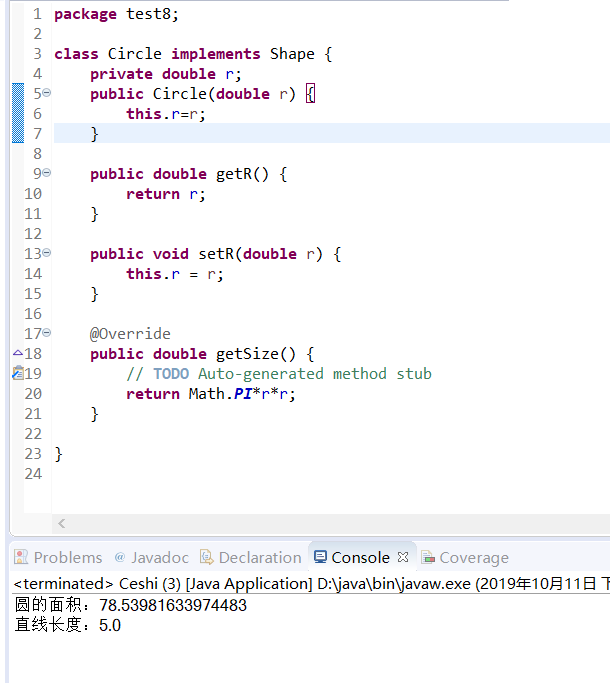第七周总结&第五次实验报告
学习总结
这周我们加深了对抽象类与接口的学习,获得的知识点也比上周多了许多,抽象类与接口很相似,就比如别人还没有做完的是交给你来做,而他那些样式都做好了,你只需要完善即可
但也有不同点。
| 区别点 | 抽象类 | 接口 |
|---|---|---|
| 定义 | 包含一个抽象方法的类 | 抽象方法和全局变量的集合 |
| 组成 | 构造方法、抽象方法、普通方法、常量、变量 | 常量、抽象方法 |
| 使用 | 子类继承抽象类(extends) | 子类实现接口(implements) |
| 关系 | 抽象类可以实现多个接口 | 接口不能继承抽象类,但允许继承多个接口 |
| 常见设计模式 | 模板设计 | 工厂设计,代理设计 |
| 局限 | 抽象类有单继承的局限 | 接口没有单继承的局限 |
| 实际 | 作为一个模板 | 是作为一个标准或不是一种能力 |
| 对象 | 都通过对象的多态性产生实例化对象 | 都通过对象的多态性产生实例化对象 |
| 选择 | 如果抽象类和接口都可使用的话,优先使用接口,因为避免单继承的局限 | 如果抽象类和接口都可使用的话,优先使用接口,因为避免单继承的局限 |
| 特殊 | 一个抽象类中可以包含多个接口,一个接口中可以包含多个抽象类 | 一个抽象类中可以包含多个接口,一个接口中可以包含多个抽象类 |
这周我们还学习了一个特殊的类object类,object类就像一个公共类,如果一个类没有明显的继承一个类,那么它就是object的子类了。
实验报告
(一)抽象类的使用
设计一个类层次,定义一个抽象类--形状,其中包括有求形状的面积的抽象方法。 继承该抽象类定义三角型、矩形、圆。 分别创建一个三角形、矩形、圆存对象,将各类图形的面积输出。注:三角形面积s=sqrt(p(p-a)(p-b)*(p-c)) 其中,a,b,c为三条边,p=(a+b+c)/2
抽象父类
package test7;
abstract class Shape {
abstract public double Area();
}
三角形
package test7;
public class Triangle extends Shape {
private double a;
private double b;
private double c;
public Triangle(double a,double b,double c) {
this.a=a;
this.b=b;
this.c=c;
}
public double getA() {
return a;
}
public void setA(double a) {
this.a = a;
}
public double getB() {
return b;
}
public void setB(double b) {
this.b = b;
}
public double getC() {
return c;
}
public void setC(double c) {
this.c = c;
}
public double Area() {
double p=(a+b+c)/2;
return Math.sqrt(p*(p-a)*(p-b)*(p-c));
}
}
矩形
package test7;
public class Ractangle extends Shape {
private double height;
private double width;
public Ractangle(double height,double width) {
this.height=height;
this.width=width;
}
public double getHeight() {
return height;
}
public void setHeight(double height) {
this.height = height;
}
public double getWidth() {
return width;
}
public void setWidth(double width) {
this.width = width;
}
public double Area() {
return height*width;
}
}
圆形
package test7;
public class Circle extends Shape {
private double r;
public Circle(double r) {
this.r=r;
}
public double getR() {
return r;
}
public void setR(double r) {
this.r = r;
}
public double Area() {
return Math.PI*r*r;
}
}
测试类
package test7;
public class Ceshi {
public static void main(String[] args) {
// TODO Auto-generated method stub
Shape s1=new Triangle(4,5,6);
Shape s2=new Ractangle(7,8);
Shape s3=new Circle(4);
System.out.println("三角形面积:"+s1.Area());
System.out.println("长方形面积:"+s2.Area());
System.out.println("圆形面积:"+s3.Area());
}
}
运行截图

(二)接口技术
1定义接口Shape,其中包括一个方法size(),设计“直线”、“圆”、类实现Shape接口。分别创建一个“直线”、“圆”对象,将各类图形的大小输出。
package test8;
interface Shape {
public double getSize();
}
圆类
package test8;
class Circle implements Shape {
private double r;
public Circle(double r) {
this.r=r;
}
public double getR() {
return r;
}
public void setR(double r) {
this.r = r;
}
public double getSize() {
// TODO Auto-generated method stub
return Math.PI*r*r;
}
}
直线类
package test8;
class Line implements Shape {
private double x1,y1,x2,y2;
public Line(double x1,double y1,double x2,double y2) {
this.x1=x1;
this.y1=y1;
this.x2=x2;
this.y2=y2;
}
public double getX1() {
return x1;
}
public void setX1(double x1) {
this.x1 = x1;
}
public double getY1() {
return y1;
}
public void setY1(double y1) {
this.y1 = y1;
}
public double getX2() {
return x2;
}
public void setX2(double x2) {
this.x2 = x2;
}
public double getY2() {
return y2;
}
public void setY2(double y2) {
this.y2 = y2;
}
public double getSize() {
return Math.sqrt((x2-x1)*(x2-x1)+(y2-y1)*(y2-y1));
}
}
测试类
package test8;
public class Ceshi {
public static void main(String[] args) {
// TODO Auto-generated method stub
Shape s1=new Circle(5);
Shape s2=new Line(4,5,7,9);
System.out.println("圆的面积:"+s1.getSize());
System.out.println("直线长度:"+s2.getSize());
}
}
运行截图



